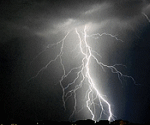Frequently Asked Questions
What is lightning?
 Lightning is the phenomenon which accompanies the discharge of atmospheric charges from cloud to cloud or from cloud to earth. As lightning seeks the path of least resistance, it naturally tends to follow the shortest course between cloud and earth, such as buildings or towering projections. As illustrated, positive electrical charges gather in the clouds and negative charges gather in the ground. When the attraction between these two charges is strong enough they come together in the form of lightning. Lightning rod equipment, properly manufactured and installed, dissipates these charges…Find out more
Lightning is the phenomenon which accompanies the discharge of atmospheric charges from cloud to cloud or from cloud to earth. As lightning seeks the path of least resistance, it naturally tends to follow the shortest course between cloud and earth, such as buildings or towering projections. As illustrated, positive electrical charges gather in the clouds and negative charges gather in the ground. When the attraction between these two charges is strong enough they come together in the form of lightning. Lightning rod equipment, properly manufactured and installed, dissipates these charges…Find out more
Does lightning always strike the highest object?
NO. While this is generally true, in many instances, lower objects are often hit first.
Is it true lightning nevers strikes the same spot twice?
NO. A good example is the Empire State Building, which is struck an average of 100 times per year.
Does a lightning protection system attract lightning?
NO. A lightning protection system will not attract lightning but offers a safe path for it to follow, which allows the strike to travel safely to ground.
Is it true lightning protection is no longer used as it was on farms and farmhouses in the 40’s and 50’s?
NO. Today, lightning protection systems are specified by architects, owners and engineers for all kinds of public buildings and commercial applications. Thousands of installations are provided each year by qualified lightning protection system installers all across the U.S.
Our home is grounded. Doesn’t that protect us?
NO. A house may be grounded to assure electrical safety, however, grounding is not intended to prevent lightning damage.
Our antenna is grounded; doesn’t that protect us?
NO. An antenna is not designed to handle a lightning strike and instead, allows dangerous current to enter the home.
Don’t trees protect our home?
NO. Many times after trees are struck, the lightning side flashes to the house.
